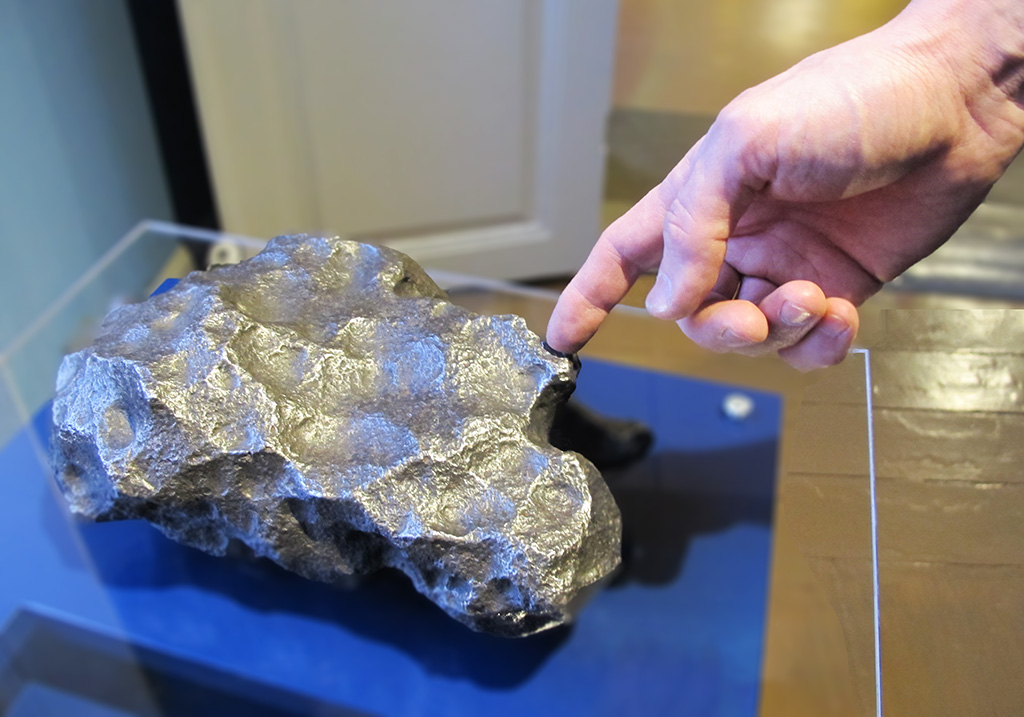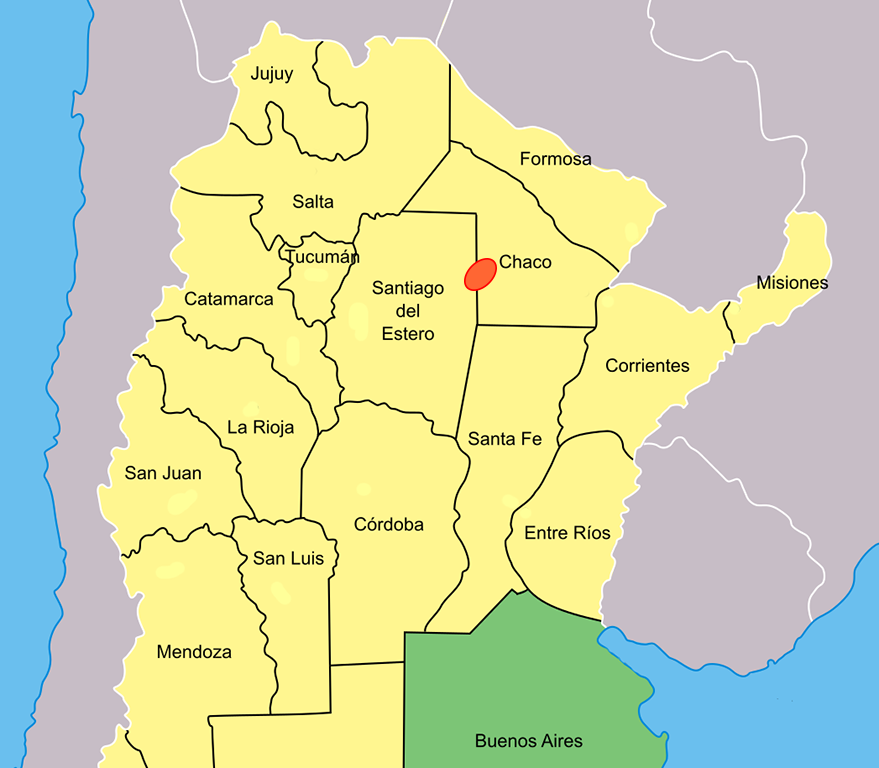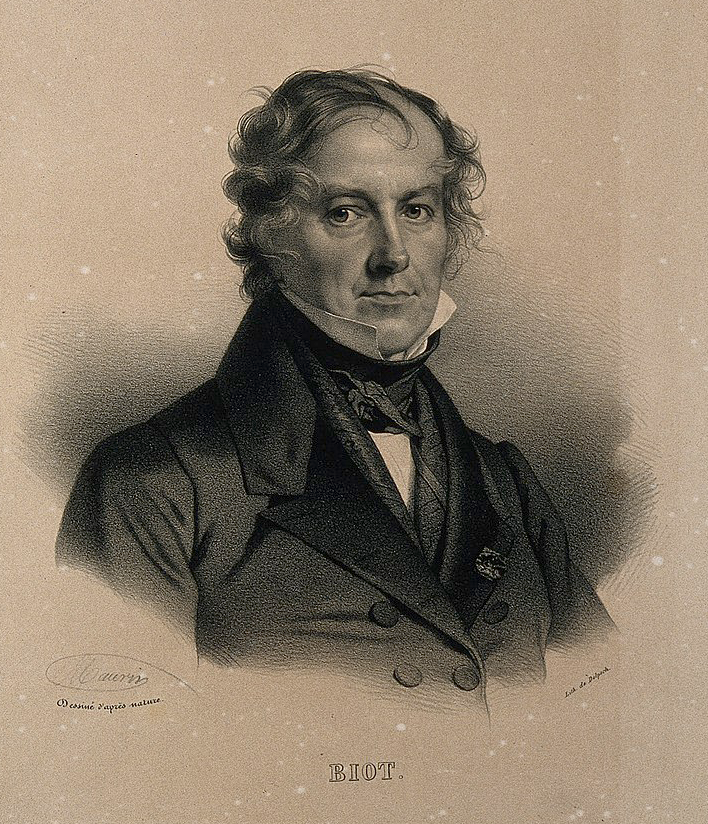Old objects are usually not to be touched in exhibitions, but the meteorite at Helsinki Observatory is an exception to the rule. Despite being far older than any other object at the Observatory, the public are expressly invited to touch it. To celebrate the 10-year anniversary of the Observatory’s permanent exhibition, our object of the month in October is the meteorite at Helsinki Observatory.

From Argentina to the Observatory
A meteorite is a solid piece of debris from an object that originates in outer space and has survived its passage through a possible atmosphere to reach the surface of a planet or moon. The Observatory’s meteorite is an iron meteorite weighing 19.2 kilograms that was created in the early days of the Solar System some 4.5 billion years ago. Only a small portion of meteorites are iron meteorites, which consist, more precisely, of an iron–nickel alloy.
The meteorite at Helsinki Observatory is part of the large Campo del Cielo group of meteorites, which were originally part of an asteroid that broke into several fragments upon entry. Approximately 100 tonnes of meteorite material has been found on the 57 km2 site in Argentina. By some estimates, the original body that entered the atmosphere weighed some 600 tonnes, of which approximately half would have reached the surface of the Earth. That means another 200 tonnes may still be out there waiting to be found!

In total, the Campo del Cielo site covers approximately three kilometres in width and 19 kilometres in length and contains at least 26 craters. In the 1960s the geologist Bill Cassidy excavated two craters, collected carbon samples and estimated that the impact took place approximately 2,200–2,700 years before the Common Era, that is, close to 5,000 years ago. In general, scientific study of the area has been hindered by its fame: unauthorised excavations have been carried out and meteorite fragments removed. In the 1990s an attempt was even made to steal what was then known as the largest fragment, the 29-tonne El Chaco.
Rocks falling from the sky?
The indigenous population of the area called the site Piguem Nonraltá, which the Spanish translated as Campo del Cielo (‘Field of heaven’ or ‘Field of sky’). Many local myths describe the impact, and according to certain old beliefs, the meteorite was part of the Sun.
Although the indigenous population appears to have known that the meteorite originated outside the Earth, Europeans long found it difficult to believe in rocks – not to mention iron objects – falling from the sky. In 1794 the physicist Ernst Chladni published a work suggesting that meteorites originated from space. He initially hesitated to publish the work because he knew he was challenging the centuries-long notion that the Moon was the only small object in space. Luckily for him, several meteorite impacts were observed in the 1790s, lending credence to his theory. However, he never visited the sites in question or interviewed witnesses. The idea of rocks falling from the sky was still commonly found incredible.
When a meteorite fell on L’Aigle in France in 1803, the physicist Jean-Baptiste Biot took a step further by travelling to the site. And he found evidence: the rock clearly stood out from its surroundings and resembled a rock found in Barbotan, France, after a meteorite impact in 1790. Biot also interviewed people who had observed the “meteor shower of rocks” and described very similar observations despite not knowing each other. Although the report was read as a fictional story, it had a degree of scientific accuracy, and only a few months after its publication, the scientific community accepted the idea of meteorites falling from space.

On the trail of a heavenly iron vein
After learning that the metal used by the locals was iron fallen from the sky, Europeans decided to set out to look for Piguem Nonraltá. Dreaming of a massive iron mine, the governor of the province of Tucumán authorised Captain General Hernán Mexia de Miraval to search for the iron deposit in 1576. De Miraval and his eight assistants found the deposit with the help of local guides in the province of Chaco in northern Argentina. They extracted specimens of what was described as uncommonly pure iron. Without an order from the Crown, however, it would have been illegal to establish a mine, so that was the end of the matter. De Miraval’s discovery was soon forgotten although both the governor’s order and de Miraval’s description of the difficult expedition were carefully archived.
Various expeditions set out to search for the iron deposit again in 1774, 1779 and 1783. Based on their observations, the iron was variously thought to be a major iron vein, the result of volcanic activity or a thin iron plate. The possibility of the vein containing silver raised particular interest, but no evidence was found. This deposit, called El Mesón de Fierro, has remained something of a mystery: did the various expeditions find the same deposit several times, or was it, in fact, a group of large meteorites that were part of Campo del Cielo? Based on the explorers’ reports, the observations made by the expeditions differed somewhat, which suggests the finds may be from different locations in the Campo del Cielo area. This means establishing an iron mine would have been unnecessary because the iron was on the ground to begin with. Although the legendary El Mesón de Fierro has been sought in modern times, it has not been found even with the help of magnetometers.
To whom do meteorites belong?
A whole host of Campo del Cielo meteorites may still be awaiting discovery, but rather than having people search for meteorites, researchers hope that the site will be more clearly regulated to enable the reliable investigation of the craters. The area in the province of Chaco has recently been protected by law, but the site in Santiago del Estero remains unregulated. Some craters have disappeared under roads, for instance.
It is possible to find meteorites in Finland too, but it is not entirely clear to whom they belong. The finds made thus far are included in the collections of the Finnish Museum of Natural History (Luomus) and displayed in Kumpula Manor in Helsinki. Any new meteorite discoveries can be reported to the Geological Survey of Finland (GTK).
The meteorite at the Helsinki Observatory has provided the public with a hands-on exhibit of a small object from space, inspiring visitors ever since 2013 to learn more about space. Because the Earth has experienced major upheavals reaching down to the bedrock, meteorites that hit the Earth are the oldest objects humans can touch.
Saara Seppälä, guide
Translation: University of Helsinki Language Services.
Instructions of the Geological Survey of Finland for delivering rock samples: https://kivinayte.gtk.fi/en/instructions/
Sources
Emiliani, Cesare 1992. Planet Earth: Cosmology, Geology, and the Evolution of Life and Environment. Cambridge: Cambridge University Press.
Viano, Lucas. “Meteorite Thefts Pose a Problem in Ancient Impact Field”. Scientific American, 19 June 2015. https://www.scientificamerican.com/article/meteorite-thefts-pose-a-problem-in-ancient-impact-field/ (accessed on 13 October 2022).
Bobrowsky, Peter T. & Rickman, Hans 2007. Comet/Asteroid Impacts and Human Society: An Interdisciplinary Approach. Berlin: Springer Science & Business Media.
Gerald, Joseph Home McCall, Bowden, A. J. & Richard John Howarth 2006. The History of Meteoritics and Key Meteorite Collections: Fireballs, Falls and Finds. London: Geological Society of London.
